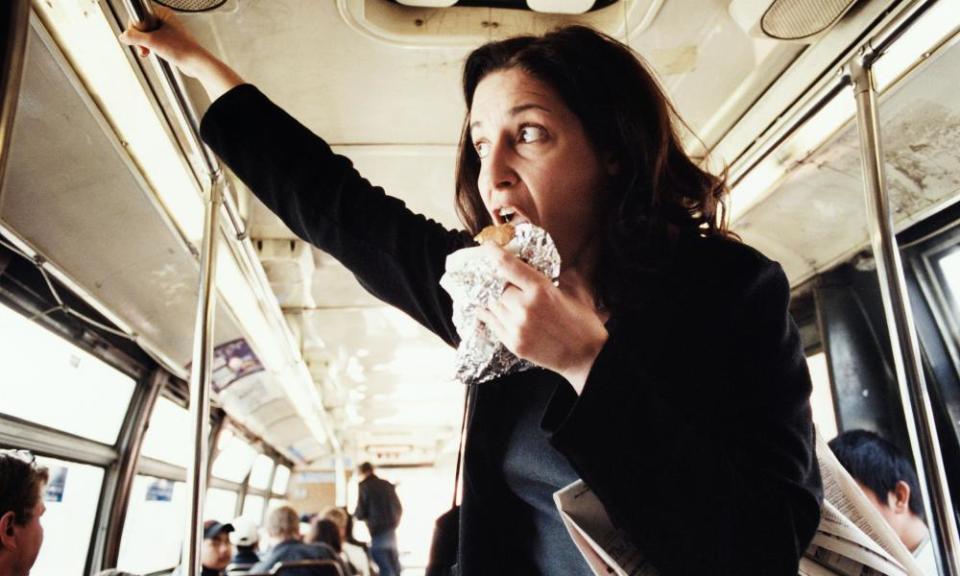Public eating is fraught. If hotdogs at the cinema are OK, why not a bacon bap at a play?

A woman next to me on the bus the other day ate a lasagne out of a cardboard box. Slithery sheets of pasta, gloopy sauce and just a small plastic fork. It was something of a struggle for her. For me, it wasn’t as bad as the smell of hot tuna on the tube or the kids who leave chicken boxes everywhere. But lasagne? Is this now considered a portable food?
I am as bemused by it as I am by sales of boiled eggs and spinach leaves in little plastic pots. Does anyone actually think, “I really want a boiled egg and some leaves – how can I possibly get one without the intense labour involved in actually boiling an egg?” Obviously some do – perhaps because they have become crazed by protein. Indeed, as the range of foods we graze on expands, so do the places we think we can eat them. We can have whatever we want, wherever we are.
Now it is necessary to tell theatregoers that they cannot munch their way through – I don’t know, a burrito? Some sushi? A bowl of couscous? – during a performance. What fresh deprivation is this? Those attending Who’s Afraid of Virginia Woolf at the Harold Pinter theatre in London have been asked not to eat during the show because some parts of the play “are extremely intense and quiet”.
The show’s star, Imelda Staunton, has had similar issues with this phenomenon in the past, saying she did not understand “this obsession with having to eat and drink something at every moment”. These actor types! First they came for your phones, now they are coming for your boiled sweets. You may pay £100 a ticket, but you will not slurp. I like this audacity, I like that they are saying, “This is not a public space, this is something different.”
This has to be said because our definition of what it is OK to do in public spaces has shifted. The boundaries are blurred. If you can have a hotdog in the cinema, why can’t you have a bacon bap at a play? On public transport, men nurse their stinky burgers; women pick at cold, dead salads. Salad remains a food women are permitted to eat in public – in private, we guzzle artificially sweetened yoghurt while climaxing over some reduced-fat cream cheese, of course.
Eating in public, however, is fraught. Some consider it a low-rent and unspeakably vulgar thing to do. Women are shamed for it. There have been Facebook groups set up for the shaming of women eating on the tube. Eating is a reminder of other appetites, and showing any appetite in public is not “classy” or “feminine”. When I was a girl, I was told never to be seen eating in my school uniform. “I’ll just take it off then, Miss.” The likes of Kate Middleton can never be seen to eat in public while her husband can chomp away. There is something both out of control and intimate about being seen eating, something that we all recognise. Middleton may simply not want to be photographed from an unflattering angle – we remember what happened to Ed Miliband – but many women have all sorts of anxieties about consuming food in public. Too much. Too little.
Still a lot of women feel uneasy about eating alone in a restaurant. They would rather shovel food into their mouths where no one can see, where there is no accusatory gaze. Sometimes we would rather not be aware of what we are doing. But the culture of constant grazing is the opposite of the sense of food as a social experience. It is intensely antisocial. Everyone is caught up in this snack-based ennui.
This food culture runs counter to the vast circulation of images of and knowledge about food. The public space that matters is not actual but visual, the one overrun by Instagrammed beauty. The phone has become the sixth sense. How it looks matters more than how it feels. Construct a selfie with the menu: while seated, cover your face with an open menu; we should only see your eyes. Here you are in a restaurant – you, your plate, your friends sharing your joy; this is how you want to appear eating in public.
But this is not most people’s experience of eating at all, is it? There is a lot of this solitary grazing. There is a lot of eating that does not involve sitting at a table with a knife and fork. Every slimming club in the world will tell you the same as a posh health spa or indeed a monastery: don’t do anything else as you eat. Don’t watch TV or be online. Be there with your food. Be present. Be mindful. Be thankful. Be conscious with your cucumber. It’s a beautiful fantasy.
Because Staunton’s small request reveals another reality: that, actually, people do now think that leisure means having to eat and drink something at every moment. I certainly do. The idea that hours go by where something else is more important than stuffing our mouths, or requires our full attention, is ... well, strange. A violation of our basic right to a halloumi wrap whenever we want it.

 Yahoo News
Yahoo News 